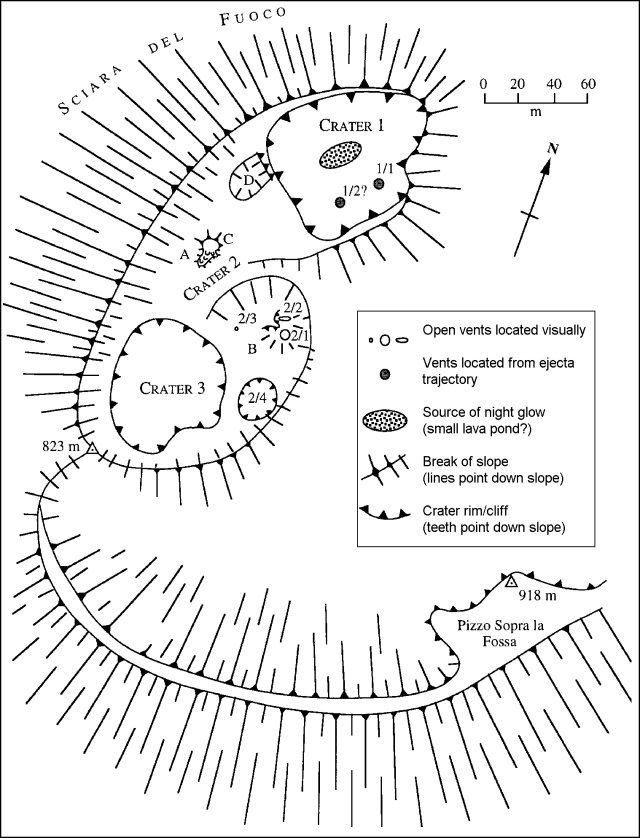Report on Stromboli (Italy) — May 1997
Bulletin of the Global Volcanism Network, vol. 22, no. 5 (May 1997)
Managing Editor: Richard Wunderman.
Stromboli (Italy) New map of the crater terrace
Please cite this report as:
Global Volcanism Program, 1997. Report on Stromboli (Italy) (Wunderman, R., ed.). Bulletin of the Global Volcanism Network, 22:5. Smithsonian Institution. https://doi.org/10.5479/si.GVP.BGVN199705-211040
Stromboli
Italy
38.789°N, 15.213°E; summit elev. 924 m
All times are local (unless otherwise noted)
A 7-hour visit on 23 May led to the construction of a crater terrace map (figure 55). The Crater 2 pit mapped in 1994 and 1995 had filled in and was occupied by an inactive lava flow fed from a small truncated cone. From information by Jürg Alean (BGVN 22:03) it was inferred that this flow was emplaced between 25 April and 19 September 1996. A new subsidence bowl was forming to the SE of the former Crater 2 pit. This was occupied by a pit crater and three vents (2/1, 2/2, and 2/3), none of which exhibited explosive activity. Vent 2/1, ~4 m in diameter, was the source of regular (~1/s) gas puffs and occasional gas release, and also showed night incandescence.
Activity during the 23 May visit was at lower levels than seen in either October 1994 (BGVN 19:10) or September 1995 (BGVN 20:11/12). However, excellent viewing conditions revealed that major changes had occurred since the 1994 and 1995 surveys (BGVN 22:03).
During the intervals 1100-1400 and 1900-2200, no eruptions were observed from Crater 3. However, at about1400 on 24 May, an explosion from Crater 3 fed a brown ash cloud that rose ~200 m above the crater rim. This was observed from the sea.
Night-time temperature measurements obtained from Pizzo Sopra la Fossa using a Minolta/Land 152 infrared thermometer (corrected for an emissivity of 0.956) gave 2/1 vent temperatures of 670-699°C. Vents 2/2 and 2/3 (~3 x 1 m and <1 m wide, respectively) were actively degassing without incandescence. The site of hornitos in 1994 and 1995 was occupied by a pit, with a wall on the NE side.
Crater 1 was occupied by two active vents (1/1 and 1/2). Between 1055 and 1155 on 23 May eight explosions occurred from these two vents. The first two explosions sent bombs 100-200 m above the crater rim with ~20% of the ejecta landing on the upper Sciara. The following six explosions sent ejecta up to 50 m above the vent.
For the next two hours, Crater 1 exploded ~1-2 times/hour, but additional sloshing and gas release sounds were occasionally audible from Pizzo Sopra la Fossa. By the evening of 23 May, Crater 1 activity had escalated to levels similar to the 1055-1155 period. As darkness fell, an intense pulsating glow visible over Crater 1 could have been due to a small, active lava pond on the crater floor. This may have accounted for the sloshing sounds heard earlier in the day.
Stromboli, a small island N of Sicily, has been in almost continuous eruption for over 2,000 years. Its small Strombolian explosions, which hurl incandescent scoriae above the crater rim, occur several times a day, but larger eruptions are less frequent.
Geological Summary. Spectacular incandescent nighttime explosions at Stromboli have long attracted visitors to the "Lighthouse of the Mediterranean" in the NE Aeolian Islands. This volcano has lent its name to the frequent mild explosive activity that has characterized its eruptions throughout much of historical time. The small island is the emergent summit of a volcano that grew in two main eruptive cycles, the last of which formed the western portion of the island. The Neostromboli eruptive period took place between about 13,000 and 5,000 years ago. The active summit vents are located at the head of the Sciara del Fuoco, a prominent scarp that formed about 5,000 years ago due to a series of slope failures which extends to below sea level. The modern volcano has been constructed within this scarp, which funnels pyroclastic ejecta and lava flows to the NW. Essentially continuous mild Strombolian explosions, sometimes accompanied by lava flows, have been recorded for more than a millennium.
Information Contacts: Andy Harris, HIGP/SOEST, University of Hawaii, 2525 Correa Road, Honolulu, HI 96822 USA.


